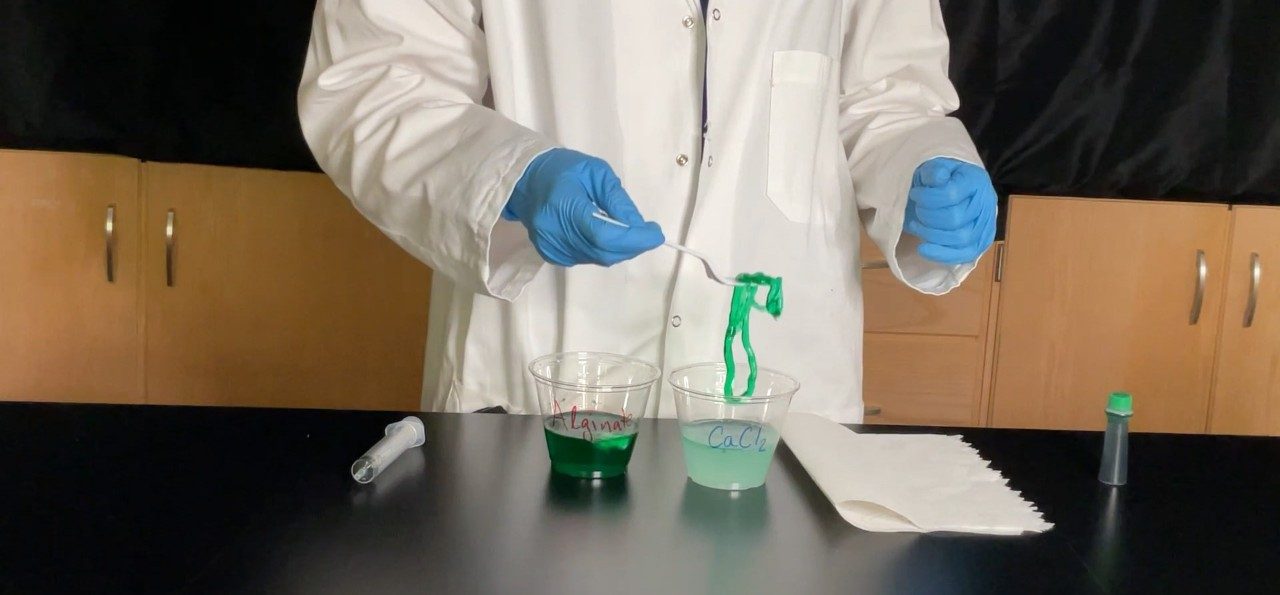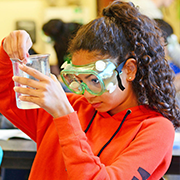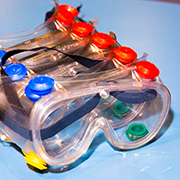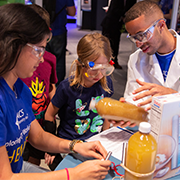Goo Worms
Ages
8 - 12 years
Activity Time
Prep: 20 mins
Activity: 5 - 20 mins
Group Size
* Participants work individually
* 1 presenter per 10 - 15 students
ACS Student Chapter at St. Louis University Presents: Goo Worms
Review with teacher or group leader to identify the appropriate concepts for your group
- Polymerization: Calcium chloride crosslinks sodium alginate molecules to make a polymer
- Uses of alginate: Alginate is used as a thickner because of its ability to polymerize
- Reaction kinetics: The alginate polymerizes so quickly that it captures liquid inside of it
This activity can get messy; cover all work surfaces.
- This activity should be done either as a video or a demonstration with the audience at least 10 from the presenter(s).
- Potential hazards include:
- Sensitizers (calcium chloride)
- Spills and splashes
- Conduct your own RAMP assessment prior to presenting this activity.
Each group should be provided:
Per 30 participants:
- 150 g (~ 3 cups) calcium chloridea
- 60 g (~ ¾ cups) sodium alginateb
- Distilled water
- Food coloring or liquid watercolor paint (optional)
a Can be found among canning supplies in online or in well-stocked grocery stores
b Can be found among molecular gastronomy supplies online or in specialty stores
- 30 syringes, without needles
- 60 clear colorless 9 oz. plastic cups
- 30 forks or slotted spoons
- Paper towels
- Permanent markers
- 30 pairs of goggles
- 30 pairs of non-latex gloves
- Additional materials identified in your RAMP analysis.
Prior to Activity
Customize Activity to Venue
- Review RAMP safety worksheet for this activity.
- Revise procedure to adapt to your specific venue and participants.
- Review activity with the teacher or group leader.
- List appropriate procedures for accidents, emergencies.
Identify Safety Practices
- Wear appropriate personal protective equipment (e.g., goggles, gloves, etc.).
- Secure loose hair, clothing.
- Prohibit eating, drinking.
- Clean work area, wash hands after activity.
- Other practices identified in RAMP worksheet.
Prepare Materials
- Prepare calcium chloride (CaCl2) solution by dissolving 150 g CaCl2 in 6 L water.
- Prepare sodium alginate solution by dissolving 60 g sodium alginate in 3 L water. Add a few drops of food coloring or liquid watercolor paint, if desired.
- For each student, label a set of 2 cups with "calcium chloride" and "sodium alginate."
On-Site
- Divide calcium chloride solution among 30 labeled cups.
- Divide sodium alginate solution among 30 labeled cups.
- Provide each student with a calcium chloride cup, a sodium alginate cup, a syringe, a fork, paper towels, goggles, gloves, and any other appropriate PPE.
- Any additional set-up for your specific venue and audience.
-
Introduce Activity
Instructions
- Explain what polymers are and that students will be making them.
Talking Points
- How do the starting liquids look?
-
Make Worms
Instructions
Direct participants to:
- Fill the syringe with sodium alginate solution.
- Squirt syringe contents into the CaCl2 solution. They should start to see what looks like a worm forming.
Talking Points
- What do you think is happening to produce the worm?
-
Examine Resulting Worm
Instructions
Direct participants to:
- Use a fork or gloved hand to pull out the worm and it place on a paper towel.
- Use the side of the fork to cut open the worm.
- Dip the cut end of the worm into the CaCl2 solution.
Talking Points
- What is inside the worm?
- Can you “heal” a cut worm? Why does that work?
-
Explore the Kinetics
Instructions
Explain the polymerization reaction.
Direct participants to:
- See who can make the longest worm.
- Try making spheres instead of worms.
Talking Points
- Can you control the shape of the worm?
- What happens if you leave the worm in the CaCl2 solution for a long time?
- What happens if you dehydrate the worm?
- What do you think sodium alginate is used for in household products?
-
Clean Up
Instructions
- Dispose of all solids from this activity in the trash.
- Dispose of all liquids down a drain with copious amounts of additional water.
- Clean all work surfaces with water or a damp cloth.
- Wash hands thoroughly.
Here are some key themes to explore with the audience once they've completed the activity. Adjust the details to match the level of your audience.
What did you make?
You made a polymer! A polymer is a huge molecule made up of smaller molecules joined together. If those small molecules are sugars, the polymer is called a polysaccharide.
Sodium alginate is a polysaccharide found in brown seaweed. It consists of long chains of tiny clusters of sugars. On a molecular level, it looks a lot like cooked spaghetti.
How does alginate become a goo worm?
When the sodium alginate meets the calcium chloride, the calcium displaces the sodium in the sodium alginate, causing those long polysaccharide molecules to clump together. The clumped polymers form an even bigger polymer that is too big to stay in solution, resulting in a gooey worm.
The polymerization reaction is very fast. If you cut open the worm, you’ll notice that some of the sodium alginate solution was trapped inside as a result. Likewise, you can “heal” a cut quickly by dipping the cut end into the calcium chloride solution. If you leave the worm in the calcium chloride solution longer, enough calcium will eventually diffuse into the worm and react with the sodium alginate inside, resulting in a firmer worm.
Applications of alginate polymer
You will notice that this polymer is soft, smooth, and easily broken. These properties make it a useful thickener for foods like ice cream, yogurt, and fruit fillings for pastries. It is also used to make dental impressions and absorbent dressings for wounds.
A process similar to that for goo worms is also used to make popping boba drinks, yogurt "ravioli," and a variety of other tasty treats. Its use as an edible replacement for food wrappers is also being explored.
References
- American Chemical Society, 2023
- ACS Student Chapter at St. Louis University






